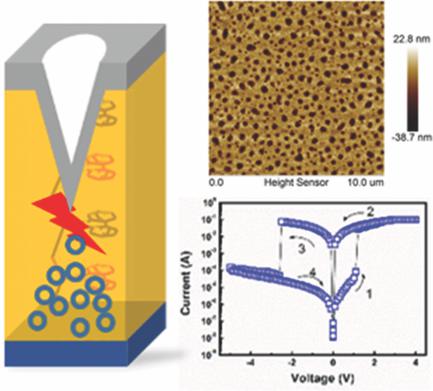当前位置:
X-MOL 学术
›
Adv. Mater.
›
论文详情
Our official English website, www.x-mol.net, welcomes your feedback! (Note: you will need to create a separate account there.)
Controllable Organic Resistive Switching Achieved by One‐Step Integration of Cone‐Shaped Contact
Advanced Materials ( IF 27.4 ) Pub Date : 2017-07-14 , DOI: 10.1002/adma.201701333 Haifeng Ling 1 , Mingdong Yi 1 , Masaru Nagai 2 , Linghai Xie 1 , Laiyuan Wang 1 , Bo Hu 1 , Wei Huang 1, 2
Advanced Materials ( IF 27.4 ) Pub Date : 2017-07-14 , DOI: 10.1002/adma.201701333 Haifeng Ling 1 , Mingdong Yi 1 , Masaru Nagai 2 , Linghai Xie 1 , Laiyuan Wang 1 , Bo Hu 1 , Wei Huang 1, 2
Affiliation

|
Conductive filaments (CFs)‐based resistive random access memory possesses the ability of scaling down to sub‐nanoscale with high‐density integration architecture, making it the most promising nanoelectronic technology for reclaiming Moore's law. Compared with the extensive study in inorganic switching medium, the scientific challenge now is to understand the growth kinetics of nanoscale CFs in organic polymers, aiming to achieve controllable switching characteristics toward flexible and reliable nonvolatile organic memory. Here, this paper systematically investigates the resistive switching (RS) behaviors based on a widely adopted vertical architecture of Al/organic/indium‐tin‐oxide (ITO), with poly(9‐vinylcarbazole) as the case study. A nanoscale Al filament with a dynamic‐gap zone (DGZ) is directly observed using in situ scanning transmission electron microscopy (STEM) , which demonstrates that the RS behaviors are related to the random formation of spliced filaments consisting of Al and oxygen vacancy dual conductive channels growing through carbazole groups. The randomicity of the filament formation can be depressed by introducing a cone‐shaped contact via a one‐step integration method. The conical electrode can effectively shorten the DGZ and enhance the localized electric field, thus reducing the switching voltage and improving the RS uniformity. This study provides a deeper insight of the multiple filamentary mechanisms for organic RS effect.
中文翻译:

通过锥形积分接触器的一步集成实现可控的有机电阻开关
基于导电丝(CFs)的电阻型随机存取存储器具有通过高密度集成体系结构缩小到亚纳米级的能力,使其成为收回摩尔定律的最有前途的纳米电子技术。与在无机交换介质中进行的广泛研究相比,现在的科学挑战是了解纳米级CFs在有机聚合物中的生长动力学,旨在实现可控的向灵活而可靠的非易失性有机存储器转换的特性。在此,本文以铝/有机/铟锡氧化物(ITO)广泛采用的垂直架构为基础,以聚(9-乙烯基咔唑)为例,系统地研究了电阻开关(RS)行为。使用原位扫描透射电子显微镜(STEM)可以直接观察到具有动态间隙区(DGZ)的纳米级Al细丝,这表明RS行为与由Al和氧空位双导电性组成的拼接细丝的随机形成有关通过咔唑基团生长的通道。通过单步积分法引入锥形接触,可以降低长丝形成的随机性。锥形电极可以有效地缩短DGZ并增强局部电场,从而降低开关电压并提高RS均匀性。这项研究为有机RS效应的多种丝状机制提供了更深刻的见解。这表明RS的行为与由长通过咔唑基团生长的Al和氧空位双导电通道组成的拼接长丝的随机形成有关。通过单步积分法引入锥形接触,可以降低长丝形成的随机性。锥形电极可以有效地缩短DGZ并增强局部电场,从而降低开关电压并提高RS均匀性。这项研究为有机RS效应的多种丝状机制提供了更深入的见解。这表明RS的行为与由长通过咔唑基团生长的Al和氧空位双导电通道组成的拼接长丝的随机形成有关。通过单步积分法引入锥形接触,可以降低长丝形成的随机性。锥形电极可以有效地缩短DGZ并增强局部电场,从而降低开关电压并提高RS均匀性。这项研究为有机RS效应的多种丝状机制提供了更深入的见解。锥形电极可以有效地缩短DGZ并增强局部电场,从而降低开关电压并提高RS均匀性。这项研究为有机RS效应的多种丝状机制提供了更深入的见解。锥形电极可以有效地缩短DGZ并增强局部电场,从而降低开关电压并提高RS均匀性。这项研究为有机RS效应的多种丝状机制提供了更深入的见解。
更新日期:2017-07-14
中文翻译:

通过锥形积分接触器的一步集成实现可控的有机电阻开关
基于导电丝(CFs)的电阻型随机存取存储器具有通过高密度集成体系结构缩小到亚纳米级的能力,使其成为收回摩尔定律的最有前途的纳米电子技术。与在无机交换介质中进行的广泛研究相比,现在的科学挑战是了解纳米级CFs在有机聚合物中的生长动力学,旨在实现可控的向灵活而可靠的非易失性有机存储器转换的特性。在此,本文以铝/有机/铟锡氧化物(ITO)广泛采用的垂直架构为基础,以聚(9-乙烯基咔唑)为例,系统地研究了电阻开关(RS)行为。使用原位扫描透射电子显微镜(STEM)可以直接观察到具有动态间隙区(DGZ)的纳米级Al细丝,这表明RS行为与由Al和氧空位双导电性组成的拼接细丝的随机形成有关通过咔唑基团生长的通道。通过单步积分法引入锥形接触,可以降低长丝形成的随机性。锥形电极可以有效地缩短DGZ并增强局部电场,从而降低开关电压并提高RS均匀性。这项研究为有机RS效应的多种丝状机制提供了更深刻的见解。这表明RS的行为与由长通过咔唑基团生长的Al和氧空位双导电通道组成的拼接长丝的随机形成有关。通过单步积分法引入锥形接触,可以降低长丝形成的随机性。锥形电极可以有效地缩短DGZ并增强局部电场,从而降低开关电压并提高RS均匀性。这项研究为有机RS效应的多种丝状机制提供了更深入的见解。这表明RS的行为与由长通过咔唑基团生长的Al和氧空位双导电通道组成的拼接长丝的随机形成有关。通过单步积分法引入锥形接触,可以降低长丝形成的随机性。锥形电极可以有效地缩短DGZ并增强局部电场,从而降低开关电压并提高RS均匀性。这项研究为有机RS效应的多种丝状机制提供了更深入的见解。锥形电极可以有效地缩短DGZ并增强局部电场,从而降低开关电压并提高RS均匀性。这项研究为有机RS效应的多种丝状机制提供了更深入的见解。锥形电极可以有效地缩短DGZ并增强局部电场,从而降低开关电压并提高RS均匀性。这项研究为有机RS效应的多种丝状机制提供了更深入的见解。













































 京公网安备 11010802027423号
京公网安备 11010802027423号